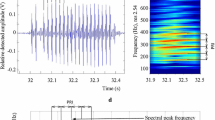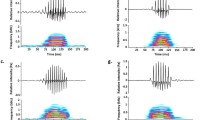Synopsis
Males of two freshwater Italian gobies, the common goby, Padogobius martensii and the panzarolo goby, Knipowitschia punctatissima, emit trains of low-frequency pulses, i.e. ‘drumming’ sounds, in the presence of a ripe female in the nest. In P, martensii the drumming sound is usually followed by a tonal sound (complex sound). Examination of the pulse structure suggests that these sounds are produced by muscles acting on the swimbladder. Both species exhibited high emission rates of spawning sounds, especially before the beginning of oviposition. Moreover, spawning sound production ceased only after the female abandoned the nest, which always occurred at the end of oviposition. This is the first study reporting the production among fishes of distinct sounds during protracted spawning. Unlike sounds produced just before mating by fishes with planktonic or demersal zygotes, the spawning sound production of these gobies does not function to coordinate mating events in the nest. The presence of a two-part vocalization by male P. martensii even suggests a functional dichotomy of spawning sounds in this species.
Similar content being viewed by others
References cited
Aiken, R.B. 1985. Sound production by aquatic insects. Biol. Rev. 65: 163–211.
Alcock, J. 1984. Animal behaviour: an evolutionary approach. Sinauer Associates Sunderland. 596 pp.
Alexander, R.D. 1967. Acoustical communication in arthropods. Ann. Rev. Entom. 12: 495–526.
Bass, A. & R. Baker. 1991. Evolution of homologous vocal control traits. Brain Behav. Evol. 38: 240–254.
Beecher, M.D. 1988. Spectrographic analysis of animal vocalizations: implications of the ‘uncertainty principle’. Bioacoustics 1: 187–208.
Bisazza, A. A. Marconato & G. Marin. 1989. Male competition and female choice in Padogobius martensi (Pisces, Gobiidae). Anim. Behav. 38: 406–413.
Brawn, V.M. 1961. Reproductive behaviour of the cod (Gadus callarias L.). Behaviour 18: 177–198.
Crawford, J.D., M. Hagedorn & C.D. Hopkins. 1986. Acoustic communication in an electric fish, Pollimyrus isidori (Mormyridae). J. Comp. Physiol. 159: 297–310.
Demski, L.S., J.W. Gerald & A.N. Popper. 1973. Central and peripheral mechanisms of teleost sound production. Amer. Zool. 13: 1141–1167.
Fine, M.L., H.E. Winn & B.L. Olla. 1977. Communication in fishes. pp. 472–518. In: T.A. Sebeok(ed.) How Animals Communicate, Indiana University Press, Bloomington.
Fish, M.P. 1954. The character and significance of sound production among fishes of the western north atlantic. pp. 1–109. In: Bulletin of the Bingham Oceanographic Collection, XIV.
Hawkins, A.D. 1986. Underwater sound and fish behaviour. pp. 114–151.
Hawkins, A.D. & A.A. Myrberg. 1983. Hearing and sound communication under water. pp. 347–405. In: B. Lewis(ed.) Bioacoustics, a Comparative Approach, Academic Press, London.
Kinzer, S. 1961. Über die Lautäusserungen der Schwarzgrundel Gobius jozo. Aquar. Terrar.-Kunde 7: 7–10.
Kishi, Y. 1979. Social behavior of the goby Tridentiger obscurus Hiyoshi Science Review 15: 127–146.
Krebs, J.R. & R. Dawkins. 1984. Animal signals: mind-reading and manipulation. pp. 380–402. In: J.R. Krebs & N.B. Davies(ed.) Behavioural Ecology: An Evolutionary Approach, Blackwell Scientific Publications, Oxford.
Lobel, P.S. 1992. Sound produced by spawning fishes. Env. Biol. Fish. 33: 351–358.
Lugli, M. 1990. Comunicazione acustica nel ghiozzo di fiume Padogobius martensi (Günther, 1861): caratteristiche strutturali, utilizzo e significato dei suoni nel repertorio comportamentale. PhD Thesis, University of Parma, Parma. 101 pp.
Michelsen, A. 1983. Biophysical basis of sound communication. pp. 3–38. In: B. Lewis(ed.) Bioacoustics, a Comparative Approach, Academic Press, New York.
Mok, H.K. 1981. Sound production in the naked goby, Gobiosoma bosci (Pisces, Gobiidae) — a preliminary study. pp. 447–455. In: W.N. Tavolga, A.N. Popper & R.R. Fay(ed.) Hearing and Sound Communication in Fishes, Springer-Verlag, New York.
Myrberg, A.A. 1981. Sound communication and interception in fishes. pp. 395–426. In: W.N. Tavolga, A.N. Popper & R.R. Fay(ed.) Hearing and Sound Communication in Fishes, Springer-Verlag, New York.
Myrberg, A.A. Jr., E. Kramer & P. Heinecke. 1965. Sound production by cichlid fishes. Science 149: 555–558.
Parvulescu, A. 1966. The acoustics of small tanks. pp. 7–13. In: W.N. Tavolga (ed.) Marine Bio-Acoustics, Vol. 2, Pergamon Press, New York.
Pavan, G.1992. A portable DSP workstation for real-time analysis of cetacean sounds in the field. pp. 165–167. In: P.G.H. Evans (ed.) European Research on Cetaceans, Vol. 6.
Pierce, J.D. Jr., K.D. Sawrey & D.A. Dewsbury. 1989. A comparative study of rodents ultrasonic vocalizations during copulation. Behav. Neur. Biol. 51: 211–221.
Satou, M., A. Shiraishi, T. Matsushima & N. Okumoto. 1991. Vibrational communication during spawning behaviour in the himè salmon (landlocked red salmon, Oncorhynchus nerka). J. Comp. Physiol. 168: 417–428.
Schneider, H. 1966. Morphology and physiology of sound-producing mechanisms in teleost fishes. pp. 135–158. In: W.N. Tavolga (ed.) Marine Bio-Acoustics, Vol. 2, Pergamon Press, New York.
Skoglund, C. 1961. Functional analysis of swimbladder muscles engaged in sound production of the toadfish. J. Biophys. Biochem. Cytol. 10: 187–200.
Smith, W.J. 1977. The behaviour of communicating. Harvard University Press, Cambridge. 545 pp.
Stout, J.F. 1975. Sound communication during the reproductive behavior of Notropis analostanus (Pisces: Cyprinidae). Amer. Midl. Nat. 94: 296–325.
Takemura, A. 1984. Acoustical behavior of the freshwater goby Odontobutis obscura. Bull. Japan. Soc. Sci. Fish. 50: 561–564.
Tavolga, W.N. 1954. Reproductive behavior in the goby fish Bathygobius soporator. Bull. Amer. Mus. Nat. Hist. 104: 427–460.
Tavolga, W.N. 1958. The significance of underwater sounds produced by males of the gobiid fish Bathygobius soporator. Physiol. Zool. 31: 259–271.
Tavolga, W N. 1964. Sonic characteristics and mechanisms in marine fishes. pp. 195–211. In: W.N. Tavolga (ed.) Marine BioAcoustics, Vol. 1, Pergamon Press, New York.
Torricelli, P. M. Lugli & G. Gandolfi. 1986. A quantitative analysis of the occurrence of visual and acoustic displays during the courtship in the freshwater goby, Padogobius martensi (Günther, 1961) (Pisces, Gobiidae). Boll. Zool. 53: 85–89.
Torricelli, P., R. Romani. 1986. Sound production in the Italian freshwater goby, Padogobius martensi. Copeia 1986: 213–216.
Torricelli, P. M. Lugli & G. Pavan. 1990. Analysis of sounds produced by male Padogobius martensi (Pisces, Gobiidae) and factors affecting their structural properties. Bioacoustics 2: 261–275.
Torricelli, P. M. Lugli & L. Bobbio. 1993. The importance of male-male competition and sexually selected dimorphic traits for male reproductive success in site-attached fishes with paternal care: the case of the freshwater goby Padogobius martensi. Mar. Behav. Physiol. 23: 231–256.
Tsao, Y.H. 1984. Uncertainty principle in frequency-time methods. J. Acoust. Soc. Amer. 75: 1532–1540.
Watkins, WA. 1966. The harmonic interval: fact or artifact in spectral analysis of pulse trains. pp. 15–43. In: W.N. Tavolga (ed.) Marine Bio-Acoustics, Vol. 2, Pergamon Press, New York.
Author information
Authors and Affiliations
Rights and permissions
About this article
Cite this article
Lugli, M., Pavan, G., Torricelli, P. et al. Spawning vocalizations in male freshwater gobiids (Pisces, Gobiidae). Environ Biol Fish 43, 219–231 (1995). https://doi.org/10.1007/BF00005853
Received:
Revised:
Issue Date:
DOI: https://doi.org/10.1007/BF00005853




